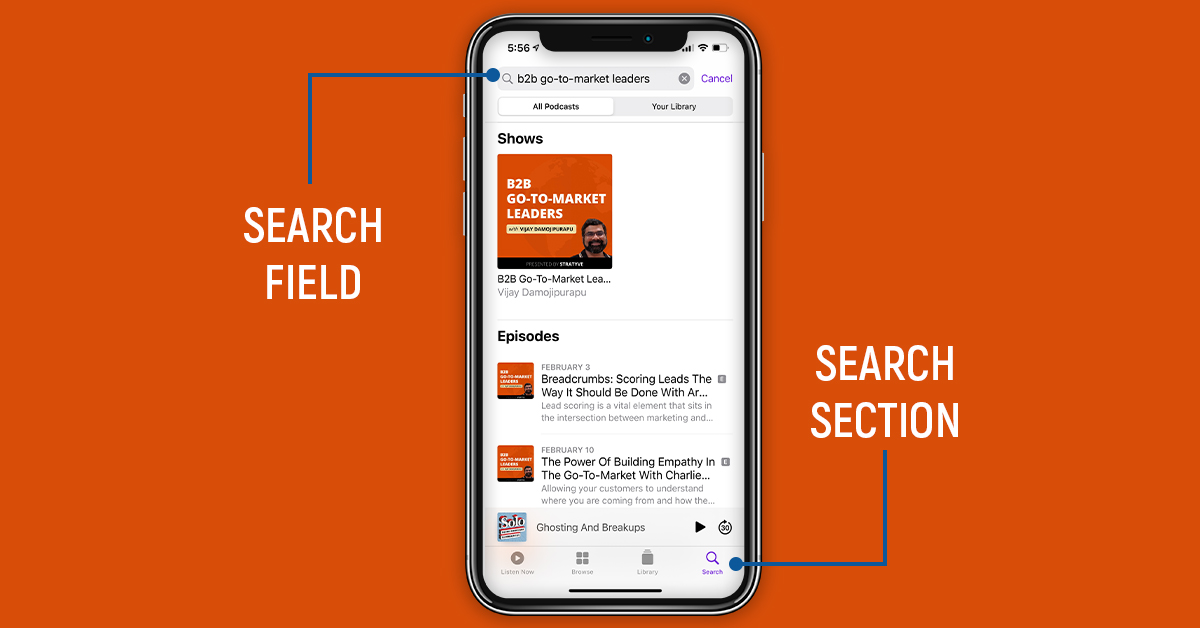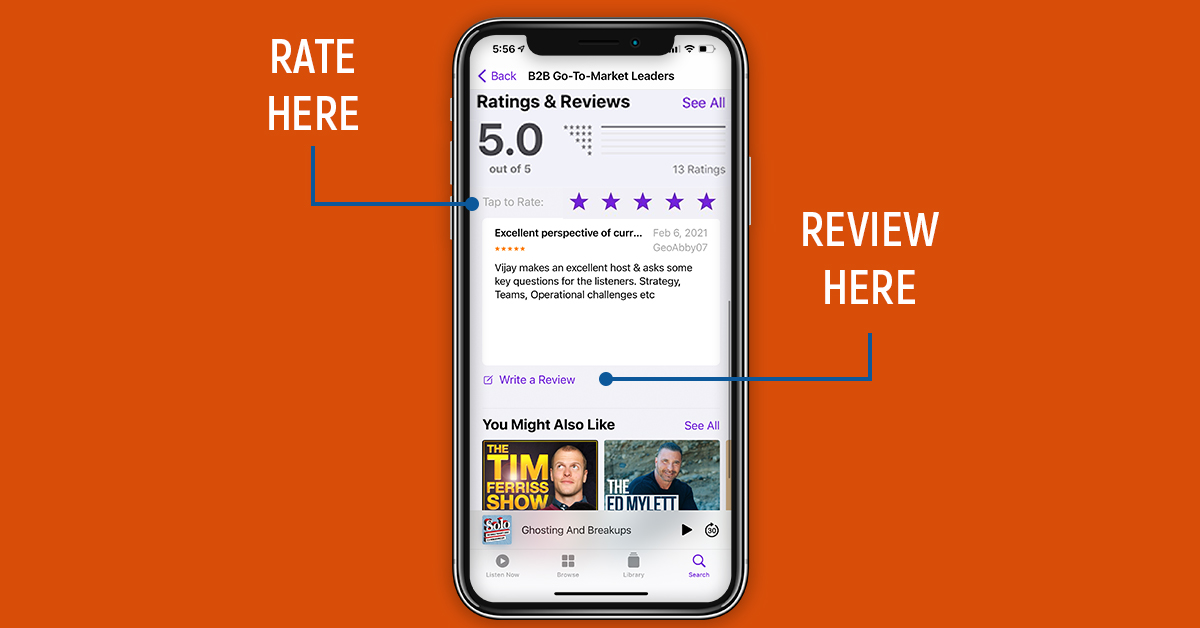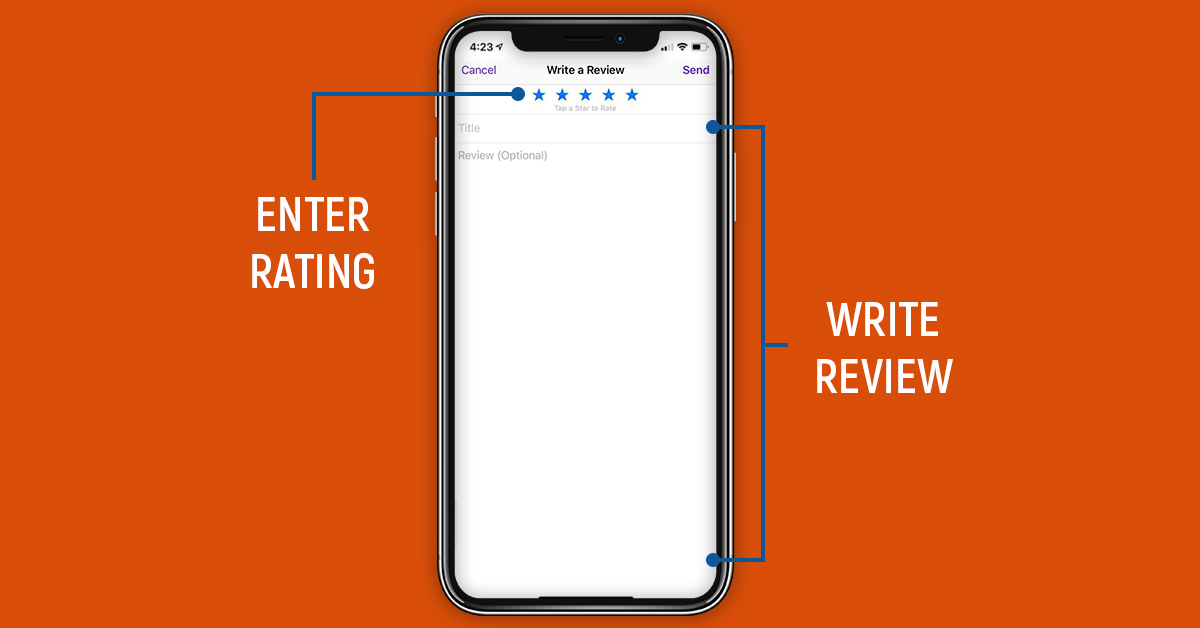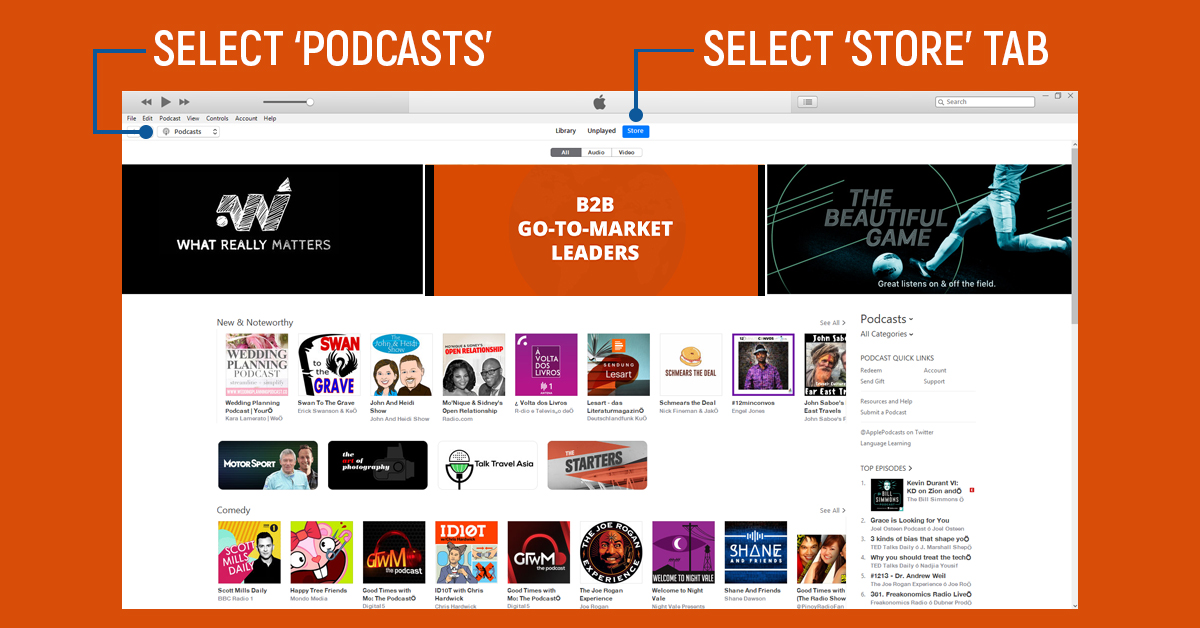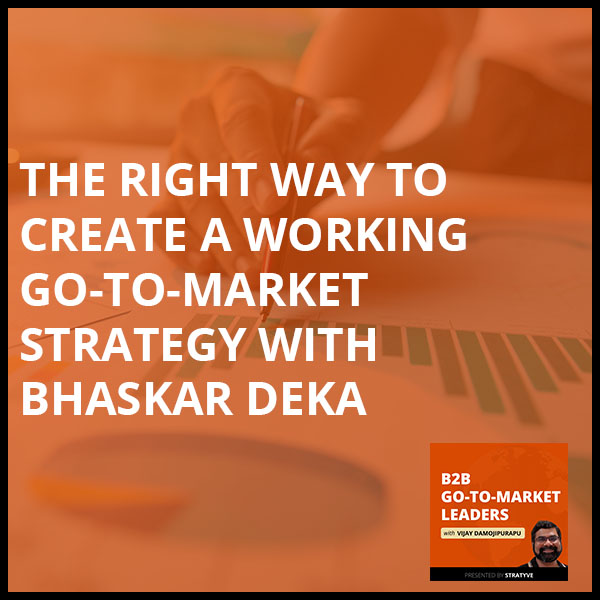
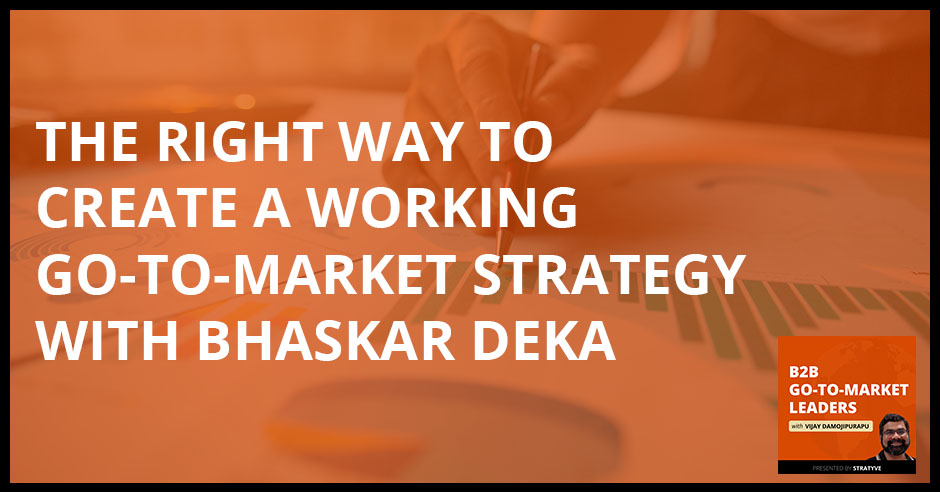
Coming up with beloved products is one of the most challenging aspects of running a business. With a well-thought and properly targeted go-to-market strategy, this process can become easier and way more efficient. To shed light on how this part of the business works, Vijay Damojipurapu interviews Bhaskar Deka, the Vice President of AI & Analytics Products at EdCast. Bhaskar goes deep on how they approach the go-to-market in their company, from using silos to their full potential, discussing their current top priorities, and considering more than one marketing direction. He also shares how to maximize resources in doing analytics and why mentorship is something every business person should never set aside.
—
Listen to the podcast here
The Right Way To Create A Working Go-To-Market Strategy With Bhaskar Deka
In this episode, I have Bhaskar Deka, who is the VP of AI Products at an up-and-coming startup named EdCast. Bhaskar, the reason why I reached out to you and I’m looking forward to having this conversation is for various things. One is you’ve got a tremendous background in the product side where you build and collaborate very closely with the engineering teams on the product. You’ve got a good and deeper perspective on AI and data science. I was impressed with your background working with larger companies, essentially the high-growth teams within other companies. You also got a good track record working with startups backed by top-tier venture capitalists. Welcome to the show, Bhaskar.
Thank you, Vijay. It’s wonderful to be here. Thank you for having me.
I start off my show with this very standard but an important question for everyone in the cross-functional teams, how do you define go-to-market?
I’ve been fortunate that I’ve been working for big companies like Oracle, Informatica in high-growth areas, as well as startups with successful exits. I’ve seen how go-to-market in particular is applicable in both for product lines, which are well-established versus product lines, which we’re still defining. Let me go back and say that fundamentally, there is a good alignment between both go-to-market as well as product management functions. What it entails is that you have a strategic component to it as well as an important or personal component. If you think about the strategic component, the go-to-market is about how do you define the overall market that you’re going after? What opportunities are there for the creation of value for our customers? If it is an existing product landscape, then what kind of competition is already out there? How would you create your unique value proposition that will differentiate your product from the rest of the competition? In the case of a new product, how would you create a new category altogether? That’s a strategic component.
When you think about it from an execution standpoint, how would you then go ahead and position and place their product around it? The classic 4Ps of marketing: Product, Placement, Price and Promotion. Those aspects need to be thought through, and that’s where the collaboration between the product team and a go-to-market team comes into play. For successful products, both in established as well as a startup scenario, you want to think about product and go-to-market teams thinking about those things and the strategic part, as well as the whole operations part. At a high level, that’s where I see that strong alignment. In the case of a startup, it can be a bit interesting because you might not have a go-to-market function yet. The founders might be acting as the people and in some cases, you don’t even have a product person. The founders are being product persons themselves. As you start going beyond your product-market fit to an actual scalable product scenario, then that distinction of GTM versus product and that collaboration comes into play.

Thank you for sharing that. Go-to-market has got both the strategic, the big picture aspect, there’s also the operational and the tactical aspect. The way I see it, and I’m sensing from what you mentioned is it’s an ongoing activity. It’s not a one-time activity and it involves collaborating with cross-function teams. Let’s shift gears a bit. Can you share your journey and important milestones, both from a professional person’s point of view, as to how and why you got attracted or pulled into a product role and data science, and some of your most recent roles and accomplishments?
I’m fortunate to have my journey in the engineering product, even a bit of product marketing and data science. I’ve been fortunate to have done work in multiple vertical domains. I started off with financial services and risk management in automotive, pharmaceutical and now learning space. My journey after my Bachelor’s and Master’s in Computer Science, I spent the first half of my career in engineering. I was a hands-on engineer. I became an engineering manager. I spent eight-plus years of my time at Oracle, mostly in the engineering space. Post my MBA, I joined the product function. The reason I was interested and intrigued by the product function in general was that I love engineering and building cool products, but I was always thinking about why you build it and how it is going to solve something for our customers?
Being in product, I think you can straddle those two areas that you were thinking about how does it solve your customer pain points and problems, and in a for-profit world, how do you make money about it working with the revenue team and the marketing team? That aspect of being able to work with engineers and build a product and as an ex-engineer, understand their constraints and the problem solving that they’re doing, but also being able to go to the other side of working with marketing and sales to be able to position their product. That’s what excites me. The other aspect of it is also going back to my journey, even when I was at school, I was a bit confused about which direction to go because I loved math, I was good at math, but I was also interested in literature. Back in those days, you either go to Engineering or Medicine.
I can connect with you, Bhaskar, but for context for the various readers from different parts of the world, this is a typical Indian parent and student mentality, the child mentality back then. You typically have two tracks, which is if you want to make money, if you want to have a good career and a good journey professionally and personally, that’s what our parents used to preach back then, “You either go to engineering or a medical profession, or you go into a technical and engineering degree.” I was in your seat and I can relate. I’m sure a lot of the folks that are from the sub-continent and the Asian region can connect with this.
Thank you for giving that context. Things have changed now. I’ve seen my nephews and my cousins and how it’s a different world now, even in places like India. Going back to the product, what I love about the product is that you should be both buoyant and a quant. You need to be able to be data-driven, understand how you’re solving problems and being data-driven around it, but also like a quant being able to distill your messages in a very short format and connect to your audience. The other aspect is being comfortable with ambiguity. Those are the things that excite me about being a product leader. I’m grateful for that journey of being an ex-engineer because it helps me connect with my engineering partners well.
Understanding value is where the partnership between the product and go-to-market begins. Share on X
Looking at your track record, you also had good stints at different startups like Skupos, and now you’re at EdCast. What got you excited to be at EdCast, and what’s your role at EdCast?
In the past few years, going back to my journey, my Master’s specialization was in AI and in those days, we were going to AI winter at that time. It used to be called expert systems. In the past few years in my start-up journey, in addition to being a product leader, I’ve been building data science teams as well. The most recent one was at Skupos. I had a product brought in to build a product team. Along with that, I also built a data science team because of what we do. What attracted me to EdCast is first of all the space itself, which is a talent and experience management, and we call ourselves Netflix or Spotify of learning.
Our founder, who I have a lot of deep respect for, is a serial entrepreneur and has done multiple startups with successful exits backed by a top-tier basis. This is for startups. He’s defined a category as the founder, and the opportunity for AI in the space, which already we are a leader in that, to do even more, especially in areas like one of my personal interests is reinforcement learning. It is where a lot of work has been done in the enterprise world and supervised and semi-supervised learning, what you do with labeled data. Tapping into human experts and how they think, how they work and how they learn translating that into what you can do in talent and experience management, I think there is an enormous opportunity there in a product suite like what we have at EdCast. It attracted me to come in and be the head of AI Products at EdCast.
From a timing point of view, as well as from the alignment of the market trends, the need in the market and there are technology trends, based on what you mentioned, it’s all coming and gelling together. Where there are a stronger need and a pull in the marketplace, be the sales team, be the marketing team, even for that matter, the product teams and even for the HR. You’ve got different functions who are constantly wanting the individuals to always up their game and be learning from the different learning management platforms or the knowledge management platforms. On top of that tying the AI, figuring out the patterns, figuring out what works well and what is best suited for this individual based on his or her learning curve, tying those two pieces, those are exciting patterns of trends that are aligning. From what you’re doing at EdCast, how do you define or how do you look at the vision and the roadmap for a product? You don’t need to get into the confidential but broadly, how do you define that?
It goes back to the first question we started our show with about understanding the market and having a unique product proposal. One thing that is unique about our environment and that our founder, Karl Mehta, who is a pioneer in this space. The company got started at Stanford. He worked with a lot of thought leaders in that space. In many ways, we are defining a category and there are other companies that came into it and we have great traction in some of the big enterprises like Boston Consulting Group and NASSCOM in India to name a few.

One of the things from a product leadership standpoint, especially in the AI space that we constantly look at is you have a real problem that you’re solving now. If you think about learning experience management and experience management, you’re thinking about giving a person in an enterprise, giving his or her role about the department that she is in and the role she does, how do we provide the most personalized, relevant, contextualized and timely content to that person? What then helps that person in her journey? Brenda was a software developer, but she wants to go into product management. Sarah is not a person who had successfully made that transition. We will be able to connect the experience, the journey and the pathways that Sarah went to and make that available to Brenda so that she can have a similar experience.
That value of being able to learn from another person and not only that individual content but also her specific journey is invaluable. If you also think about from the context of as a leader in my organization, I’m trying to do a big change management initiative and I want to know who are the people with the right skillsets that’s out there. You can think about cohorts or subclasses of people with similar skills that help me understand the landscape. The reason I also brought up reinforcement learning is because, in addition to what you can learn with existing label data, a lot of work with human experts feeding into the overall pipeline, you can make it even better.
From a strategy standpoint, that’s how I look at it. Think about the immediate value that you’re creating, but you have a long-term vision of where you want to go. That’s where the partnership between a product and a go-to-market is critical. You need to be constantly listening to your customer and being customer-centric, but as a product manager or a product management leader, you can’t be everywhere. You need to partner closely with the GTM team who are constantly talking to customers and how do you learn and partner with the real customers? Refining your roadmap or learning more from how they’re receiving or saving it are all very important aspects.
You mentioned about product and then you mentioned about go-to-market. In your mind, it looks like you are seeing them as two different entities versus in my mind, I see go-to-market as a product, you’ve got marketing, you’ve got the revenue teams and you’ve got customer success. Based on constraints on the organizational chart and leaders, there’s no one central function that has a complete interview, other than maybe the GM or the CEO. That’s one of the challenges for me personally. I’m trying to address and figure out what is the right way to address this, because go-to-market, you can say for a product, “You’ve got a vision and a roadmap that you need to execute and deliver against.”
For marketing, “You’ve got these various campaigns and programs, even sales enablement are launched for this customer even.” You need to do that. From sales, “You’ve got this quarterly quota and you can implement ABM or several other tactics. Go figure it out and get your sales revenue goals hit for the company.” Customer service is similar. Coming back to the earlier question, I want to put you in the hot seat about your thought process of product and then this go-to-market. Would you reconsider the perspective?
Start-up businesses must always have a grand vision of where they want to be as the first step. Share on X
It varies from company to company. It also varies from the stage of the product. Company to company would mean well-established market leader in one space, versus a startup defining a new category or getting into the space. Your point is well-taken that if we think in silos, we cannot be successful. That’s where I would start off with. If product is only thinking, “I need to work with engineering, build a product. I got my input from marketing. I know where to go but I’m going to build it on my own.” If marketing on the other hand thinks only about, “I need to do campaigns and product has given me all the materials. I’ll measure it to a tee and I’ll get successful.” Sales think about, “I’ve got a product. I’ve got my data collaterals. I’m going to go and sell it.”
The point you’re making is you need to be joining the hip in these functions. In many ways, the organized small structure would vary from company to company, but that full alignment in that journey about how you started with a pain point for our customer and then how you position the product. You mentioned an important stakeholder with a customer success, especially in a cloud world, “How am I keeping my retention rate to be 95% or above?” Making them delightful customers as opposed to make the sell. Even though we would execute in silos, if there’s such a thing, we need to be aligned on the strategy, joined in the hip all throughout. There are various mechanisms that you can have to go to and not having a regular product council where all the stakeholders meet constantly.
Those are all the mechanics of doing it. The key point here is that the leaders are fully aligned across all of that. I couldn’t agree more on that. The reason I brought up about the stage of the company is in a startup, all of them could be together. One person could be wearing the hats, especially go-to-market and product together. The other thing I want to make is that even when you have grown up or you’re a part of a big company, product management, since that’s my area of focus, always has this component for outbound versus inbound. Your inbound product management is more focused on building the product and having the right engineering partnership. The outbound is always about working with your customer-facing or customer success or sales and marketing. That partnership collaboration, the sooner you have it, as opposed to, “I’m going to go and build it on my own,” is what makes people successful. It’s a continuous journey and that alignment is needed across all three of them. I want to go back and say that I’m 100% in agreement with you. We have that status and the alignment, and we should be thinking end-to-end, but then execution maybe you do it in your little area.
That’s the point. In the big picture, you have one go-to-market team thinking in one direction, but then when you get into the execution and tactics, you cannot have the majority or all of the product and marketing and sales in one direction. If it’s a new product versus a mature product, each person or each role will have their own responsibilities. This is where you need to be dialed in and you need to have silos. Silos have come into existence for a reason, but there’s also a constant theme. Someone or a team within a company has to be thinking about the cross-functional aspect. Going back to what you mentioned which is you got the big picture and then you got the mechanics of the QBR and the weekly or the bi-weekly sprints, if you go back to either the current role or the last one or two roles, what would you say as an example and something that strikes your mind as to, “We as a team have achieved a wonderful go-to-market?” Does any of that come to mind for you?
People always talk about pivoting being a way of life in startup, which is in many ways true. If you look at a journey of a startup, you might have started with something, but you ended up with something else altogether. However, I call it pivoting with a plan. You don’t do pivoting and say, “This didn’t work. I’ll go and try the other one.” The successful startups always start with a grand vision of, “Here’s the space that I’m going after and then I’m trying it here,” but they always think about the other areas. Going back to your point, the way things come together, and I can give a few examples where in my previous one, we had different customer segments that we were thinking, “Our product is applicable to all of them.”

As the team came together to QBR and our multiple stakeholders, learning from customers and our product deployment, we honed it down and said, “No, this is a big enough space. If you think about the US versus the global market, and you think about the existing players or lack of existing players in there, let’s focus on that.” One area was like that. Instead of being multiple vertical-focused, we went ahead with one vertical. That was a well-enough market in a big market that led to our successful exit. If we had tried out multiple verticals, probably it wouldn’t have the same success. That is an outcome of having that honest dialogue on multi-login in which multiple stakeholders are coming together.
The point you bring up over there is critical. This is a challenge. Be it a small organization or even larger organizations, it’s about having that focus and the ability to say “no” to the rest of the opportunities. There’s that constant fear of missing out. It plays a lot in the minds of individuals, be junior med or even educators, but the successful go-to-market teams with the right leadership have that discipline of saying, “No, because we are going to focus on this one segment or initiative.” I bring up that point, it’s about that focus for not just for the next one month or one quarter, but it’s at least for a year.
In the product role, I always think about the fact that the most successful product managers are good at saying no to the right things. With experience, you get also better at it because there are many things that you can do, but how do you come up with it in a data-driven way? You can’t be right all the time, you can’t predict the future, but how do you have a framework working with multiple stakeholders, the framework of evaluating where you want to go, whether it’s the big picture about what products and portfolio you would have, down to at the end of a BM level, what features you’re building? That’s supercritical.
Going back to a story that you mentioned. Normally, we’re talking about product language here. You mentioned Brenda and Sarah, the two personas. You did a good job in framing that story because that’s clearly etched in my mind. You’ve done that bit of storytelling really well. The Brenda and Sarah example that you mentioned, clearly you got the charter as to how you can bring or help people like Brenda and Sarah within the different parts of the organization, and were looking to make that career change or thinking about how to grow in their roles. From a view point of the coming months, what are your top priorities? When you think of those top priorities, what do you see as potential hurdles and how do you plan to overcome those?
The key thing here is that product managers live by the roadmap. We as a product leader, one of the key roles is to build that roadmap. It’s not something you build and it’s a living document or artifact, and it needs to have two different aspects at a minimum. One is how you build and maintain something, which is more external focused. They’re going to talk to customers and partners. The other one is how you build something and maintain it, which is more internal focused working with the engineering and the customer success team.
The most successful product managers are good at saying no to the right things. Share on XThat aspect, that’s why you’re only thinking about getting the multiple sets of working together, quarterbacking that is something I enjoy and strongly believe in. Whether it’s product council or other QBR mechanisms that you have, that aspect of thinking from a portfolio all the way down to the tangibles of the story level, epic stories and the agile world, is how I think about and constantly measuring it. One important stakeholder I left out, which a lot of times is now subsumed within the product team is the user experience team. Sometimes you have that in a design team is out of even product.
Thinking about the customer journey and doing some rapid prototyping validation with a customer is a key part of it. That’s the other thing that I’ve missed out over there, which is once you have that working with some lighthouse customers, maybe your customer advisory board or whatever form it might be. That’s where another touchpoint between the go-to-market function and the product function is super critical. You want to be thoughtful about, given the set of customers I have, what are the segments that I can play in? Having great representations from each of those, because you could otherwise be building a product which feels nice to SMB market or one part of SMB market, but it doesn’t apply to enterprise or the other way around if you’re going after both of those as an example.
Thank you for bringing attention to something that I omitted and something that we’ll keep in mind going forward is the user experience and the design team are a key component of the go-to-market aspect as well.
It’s a good point because it’s not only the segments and the hypothesis of the prototyping at the early part of the journey, but also having product analytics once the product is in place and working with customer success and product together about whatever we set out to do, whether it’s working or not, measuring it. That input is super important for your roadmap. Things that you thought will work but didn’t work, and then you did a good amount of A/B testing initially, but then later on the product is in production and then people are using it. Learning from it and having that feedback into your product roadmap.
Can you share some of the tools that you use for analytics? I know for marketing and even for sales, we had a market tech stack and the sales tech stack. For product and for analytics, what is your tech stack look like?

Fortunately now, there are a lot of products available. In the interest of being vendor-neutral, I won’t name names, but the way I would call out is that in a product world, as compared to several years ago, first of all you have extra tools now that does portfolio planning of product, all the way down to creating roadmaps that you can share with stakeholders. There used to be days when you would have Excel spreadsheets and you have PowerPoint slides or Google slides. That’s what you do and it’s not a scalable model, but now there is structured content that you can put in all the way from your product portfolio planning that goes down to integration with your actual delivery mechanisms and to your Wiki. I’ve used quite a few of them in my product leadership role and pluses and minuses, but I won’t name any particular product. That one area, let’s call it product portfolio and then the roadmapping tool.
The other big area is in learning about the product itself and how it’s being used. We are not fortunate to have our products. It used to be that you will take Google Analytics and you try to fit it, embed it into it and there’s a Google Analytics expert who gives those reports of you. Now they are all down to specific areas that it can go after. You also have tools in the design space about how you’re building prototypes, and that leads us to Adobe Suite of design tools, but tools that integrate nicely with it. The key point is measuring what you’re able to do and not the set of tools that are out there. A lot of good literacy around the web, since I’ve used multiple of them and was successful, there have been multiple startups and big companies. I won’t name names in specific, but those two categories as a product person, you need to keep an eye on. The thing about roadmapping too, some of this can be a bit expensive or even the analytics too. For a startup, my advice would be to start with what you can do with free tools first. There’s the advantage of a paid version of a product as you scale-up, but start with free tools and then move up where you have a great subscription. It is how I’ve successfully used it.
In short, use Google Tags and spreadsheets when you’re low on budget and in a startup mode. The key point is to chase the habit within the product teams to use the more mature and advanced tools.
That reminds me of something that whether you are using a spreadsheet or a tool as an example, there are some fundamental structural things that you have in the roadmap. I made the distinction between external versus internal. In the internal one, I’m using examples from my AI world. You’re writing a recommendation engine, so you want to think about collaborative filtering. You want to think about your metrics factor addition. Those things are needed for your data scientists and your engineering team, but to the end customer, you are talking about personalized, contextualized content that you’re delivering. Having a taxonomy hierarchy of your components and roadmap, those are needed irrespective of whether you are using a mapping tool or using your Excel or PowerPoint. If you’re low on budget, that still doesn’t free you up for not having that taxonomy. It’s also easier than once you have taught to in that structured manner to move from what you have currently to a tool.
You did mention a couple of things that you are excited about and something that you are constantly keeping our eye on and studying. You mentioned various aspects of data science. Can you go a little bit deep into the things that you are looking out for and you are curious?
Each one of us has blind spots. We need to start there and look to the mentors to point them out. Share on XEspecially in the AI space, there are three major parts. If you’re not thinking about general AI, if you think about machine learning in particular, the three major parts, you have your supervised learning, semi-supervised learning and enforcement learning. There have a lot of advances being done, especially in the enterprise world now in the first two areas. If you talk about reinforcement learning, people still talk a lot about robotics or talk about games, but the applicability of that enterprise is enormous. That place is where I’m interested about. A related area of that is transfer learning. When you’re in robotics, you have trained your left arm on the robot. When you’re training the right arm, you don’t start from scratch. You transfer the knowledge that you had on your left arm.
A similar context institutionalizing that in the enterprise world, the reinforcement, in particular, there’s this sub-domain that’s called inverse reinforcement learning. You start with thinking about an expert first and then the other way around. Reinforcement learning has the concept of aids and rewards. You think from the other way around. That’s a sub-area that I’m particularly interested in and I do a lot of reading and I follow the literature. I’m deep into the scientific and academic community, what they are doing with their applicability into the enterprise world.
It looks like you lean on the scientific community and the various books or technical journals when you’re going deeper into those. If you go up one level from a go-to-market, are there resources that you lean on to improve your go-to-market management?
I would take a step back and talk about my journey as opposed to this specific area. Since I’ve been fortunate to have worked in multiple domains, that’s something that excites me because my constant team has been data, AIML in the product side build, but the domains have been different. I would give an example. When I joined Xtime, which was a successful startup bought by Cox Enterprises, that’s an automotive domain and I’m not even a car person. I drive an old car and for me, it’s a mode of transportation from point A to point B. I questioned myself, I’m excited about the business opportunity, but I’m not a car person. There are a lot of people who are passionate car lovers.
The first thing I did when I joined was, “How can I learn from experts?” A dear friend of mine, Gregg Manson, who ran Customer Success at Xtime. He was an amazing expert, who was a VP of Operations at AutoNation, a multi-billion-dollar company, the biggest car dealership in the country. Gregg taught me so much about what happens in that world. Tapping into him and it was a synergistic relationship because every time I’m thinking about how do I have a prototype with some of the customers in that space, I know I can rely on Gregg. I also can get things refined with his thinking. Using Gregg as an example, I always rely on not only what you can learn, but tapping into experts and especially business apps. I also tap regularly with my Kellogg Business Community in the Kellogg School of Management over those professors or people who are in the industry. There’s so much I can learn even in half an hour conversation with an expert. I’m trying to face a lot of materials that’s available as literature.
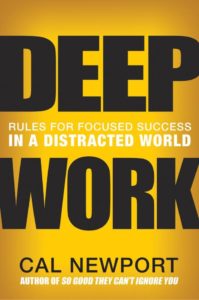
You bring up good points. This is something that I’ve seen when I speak with other go-to-market leaders is it’s often that you don’t have expertise in all the functional areas that you need to do your job well in. Relying on subject matter experts and domain experts, the example that you mentioned about Gregg, where you needed to ramp up on the whole auto industry, that’s a great example. That’s something that I’ve heard from other go-to-market leaders as well as to how they ramp up their learning on the gaps, and where they need to figure out or get car parts and perspectives. Tying back to your example, which is as you’re building the product for Xtime, you also need to connect with the various personas in the auto industry. Who do you lean on?
It’s role-independent in some ways. Mentoring aspect is important. When I made that transition from engineering to product management, a couple of people who helped me a lot who are still mentors for me to this day, Walter Hauck and Tony Gazikas, were the CIO and CTO of Pfizer Pharmaceuticals. I knew them even before I spent some time there, but this was while I was still at Oracle. As an ex-engineer and engineering manager, I thought I was good at problem-solving or a person problem solving a good framework. What they helped me was refining my thinking about the customer at a business but also, more importantly, the people management aspect of it. Pfizer as a company is well-known for its framework around it. Particularly from both of those leaders, I learned so much about the competencies that the product leader needs for the people management aspect. I’m grateful to have them as mentors. I reached out to them with questions and thoughts of scenarios I’m going to run at.
The value of having those mentors, you can accelerate your thought process. Mentors are key in pointing out the blind spots, which you may not be aware of. Each one of us has blind spots. We need to start that and look to the mentors to point that out. Bhaskar, it’s a great conversation. You’ve shared a lot of value to myself and for my company as to what I should be thinking in terms of go-to-market. You also shared a lot of value to the various readers and the product, marketing, revenue and customer experience teams. Thanks to you, you pointed out even design and user-experience teams. These are all great points that you shared. The last question that I have is if you were to rewind the time and go back in time, what would you tell your 18 or 20-year-old self now that you’ve seen your journey and where you are now?
First of all, thank you for having me. Any discussions like this, I learn a lot as well. Your key point about thinking holistically and not thinking silos, the GTM aspect is spot on. That’s a takeaway for me not to execute in silos but think together in that space and how we do it better. That’s a constant thing. Thank you for doing that. I love Jeff Bezos’ point about the regret minimization framework as the way he approaches life. I won’t say I have too many regrets in that aspect, but I would say one thing about it in that as much as I enjoy being in different verticals and aspects. It can be also tough. One book I’m reading now is called Range by David Epstein. He talks about generalists. It’s an interesting book especially for GTM folks to look into. If I could go back, I mess with this all day, I was confused about which direction to go because I love literature or that big picture world, as opposed to taking in a bit of micro-level like engineering problem-solving.
I would tell myself, “Don’t be confused.” My mom was a big influence on it saying, “Go down the engineering path. You can still come back.” That’s what I did essentially. I went to engineering and then my MBA got me into great talk partners who came from Humanities and Liberal Arts background. It’s a cliche, but the journey is more important than the destination. I would say don’t be confused and whatever your passion is, follow that. I would live it that. It may be not a thing I can say is that my daughter who’s in high school is having a similar moment. I see she’s good at writing and she is good at math. I’m giving her the same advice, “Follow your heart, but keep in mind that it’s okay to have interests in multiple, and you’ll learn what’s the right calling for you.”
On that note, a book recommendation and someone that I started admiring is this author called Cal Newport. I don’t know if you’re familiar with his son.
I’m not.
I would recommend that for you and something that you can share with your daughter as well. One book is around the whole concept of Deep Work, where these days, our human minds are distracted. Shallow thinking is becoming more and more pervasive, versus if you ask someone to sit down for 60, 90 minutes or even 120 minutes, and do one thing, people struggle now. His book on deep work is one and something that I would recommend for your daughter and for the kids out there, and the parents out there as well as they’re guiding their kids is So Good They Can’t Ignore You.
Thank you for sharing that. I’ll keep that in mind.
Thank you for a wonderful conversation, Bhaskar. I enjoyed the conversation. Personally, I’ve taken a lot of learnings. I appreciate the time that you’ve taken.
It was great chatting with you. I’ve got a lot of takeaways myself. Good luck with the rest of the sessions you have. I look forward to learning more from the shows that you will have. Thank you.
Important Links
About Bhaskar Deka
 Product & Data Science Executive with experience spanning diverse functional areas, including product management & marketing, and engineering management. Successfully led product management, data science, and engineering teams in both established public companies (Oracle, Informatica) as well as start-up/young companies through successful exits – funded by top tier VCs such as Bessemar Venture Partners, Insight Partners, and Toba Capital.
Product & Data Science Executive with experience spanning diverse functional areas, including product management & marketing, and engineering management. Successfully led product management, data science, and engineering teams in both established public companies (Oracle, Informatica) as well as start-up/young companies through successful exits – funded by top tier VCs such as Bessemar Venture Partners, Insight Partners, and Toba Capital.
Product Management experience includes leading product strategy, definition, go-to-market strategies for product suites in multiple data and business domains. Extensive experience in scaling product organization from zero to hundreds of millions of dollars in revenue.
Engineering Management experience includes leading engineering in a start up environment to build and launch a global online marketplace used by millions of users around the world.
Deep technical knowledge in areas of Cloud – Software as a Service(Saas), Infrastructure as a Service(Iaas), big data, analytics and AI/machine learning. Certifications in AI and Deep Learning from Stanford University.
MBA from Kellogg School of Management, a Master’s degree in Computer Science from Boston University, and a Bachelor’s degree in Computer Science & Engineering from Birla Institute of Technology, India.
Rhythm Guitarist, Tennis player, and Biker.
Love the show? Subscribe, rate, review, and share! http://stratyve.com/


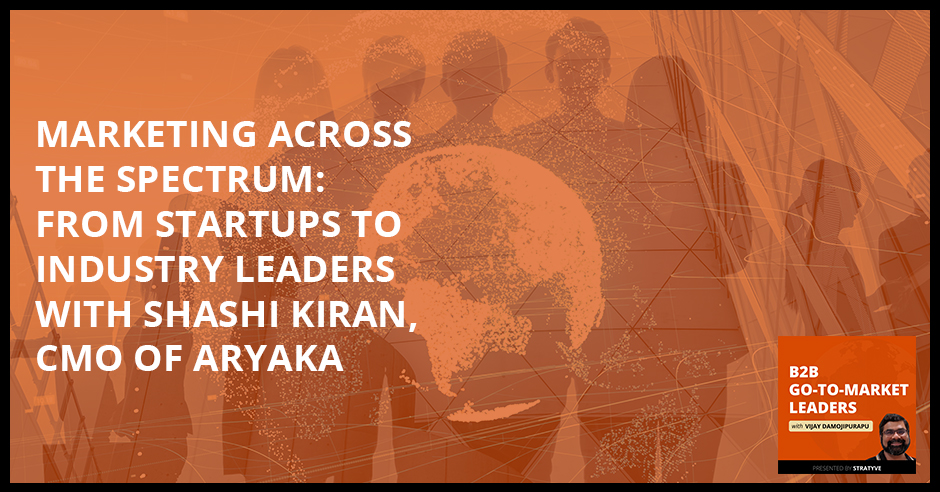



 A proven executive with 20+ years of experience in business and technology roles. I adopt a growth mindset and enjoy driving outcomes that create impact, value and deliver a positive experience. Building trust-based relationships based on integrity, authenticity and avoiding politics are core to my personality. I’ve been involved in marketing, sales, business development and product management at large global companies and smaller startups. Love solutions and connecting the dots to win big! Meritocracy, passion and humility are key ingredients of my team-building formula.
A proven executive with 20+ years of experience in business and technology roles. I adopt a growth mindset and enjoy driving outcomes that create impact, value and deliver a positive experience. Building trust-based relationships based on integrity, authenticity and avoiding politics are core to my personality. I’ve been involved in marketing, sales, business development and product management at large global companies and smaller startups. Love solutions and connecting the dots to win big! Meritocracy, passion and humility are key ingredients of my team-building formula.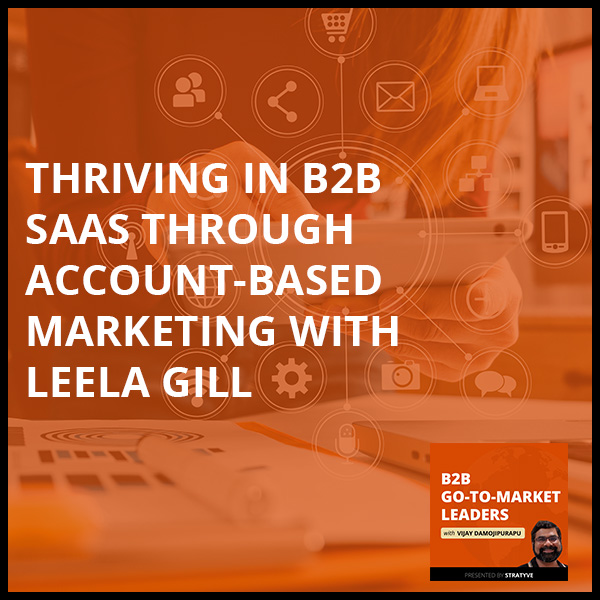




 SaaS leader with strong growth experience across sales & marketing, account management, product dev, UI/UX design, customer success & onboarding, M&A, and fundraising. Proven at profitably growing B2B revenue with Fortune 500 clients like Walmart, The Home Depot, Eli Lilly, Lockheed Martin, targeting C-suite and VP decision-makers. Responsible for go-to-market strategy, account-based marketing, field marketing, pipeline growth, lead conversion, content creation, and thought-leadership. Excellent communication skills, collaborating with technical and sales professionals to drive results.
SaaS leader with strong growth experience across sales & marketing, account management, product dev, UI/UX design, customer success & onboarding, M&A, and fundraising. Proven at profitably growing B2B revenue with Fortune 500 clients like Walmart, The Home Depot, Eli Lilly, Lockheed Martin, targeting C-suite and VP decision-makers. Responsible for go-to-market strategy, account-based marketing, field marketing, pipeline growth, lead conversion, content creation, and thought-leadership. Excellent communication skills, collaborating with technical and sales professionals to drive results.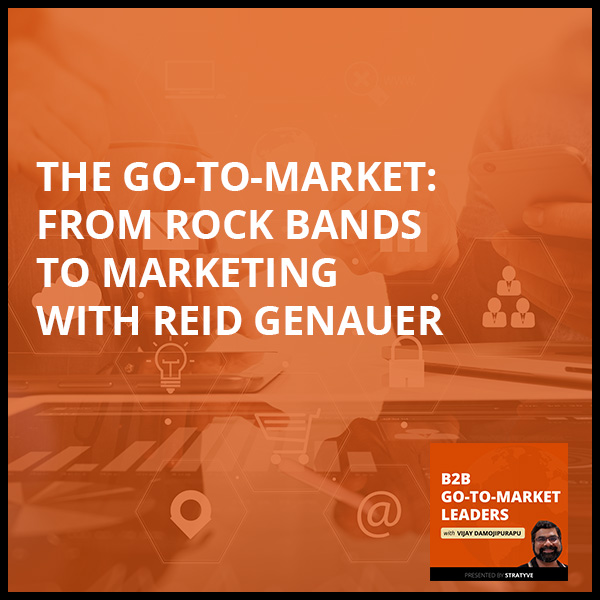
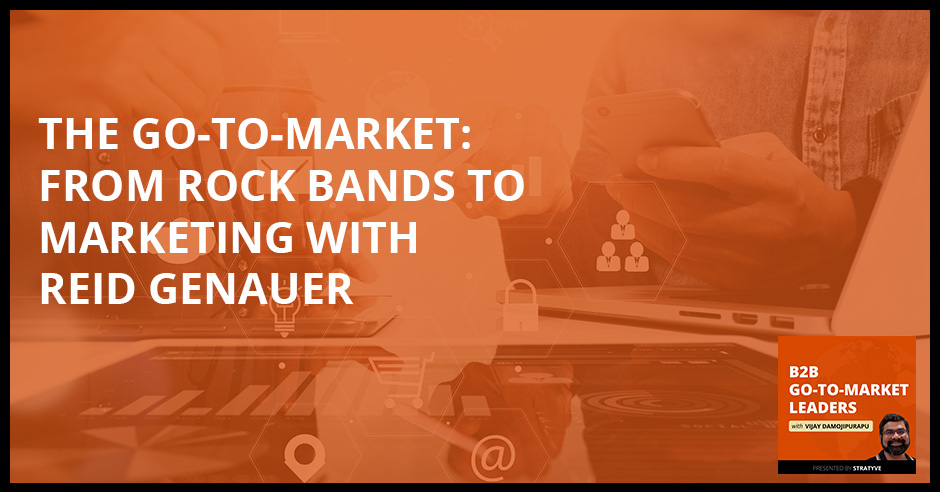



 Entrepreneur, Leader & Chief Marketing Officer (CMO) with deep experience in product market fit, data-driven growth, branding. Proven track record of scaling early-stage tech companies. Industry thought leader for mobile, social, video, music & media.
Entrepreneur, Leader & Chief Marketing Officer (CMO) with deep experience in product market fit, data-driven growth, branding. Proven track record of scaling early-stage tech companies. Industry thought leader for mobile, social, video, music & media.
















